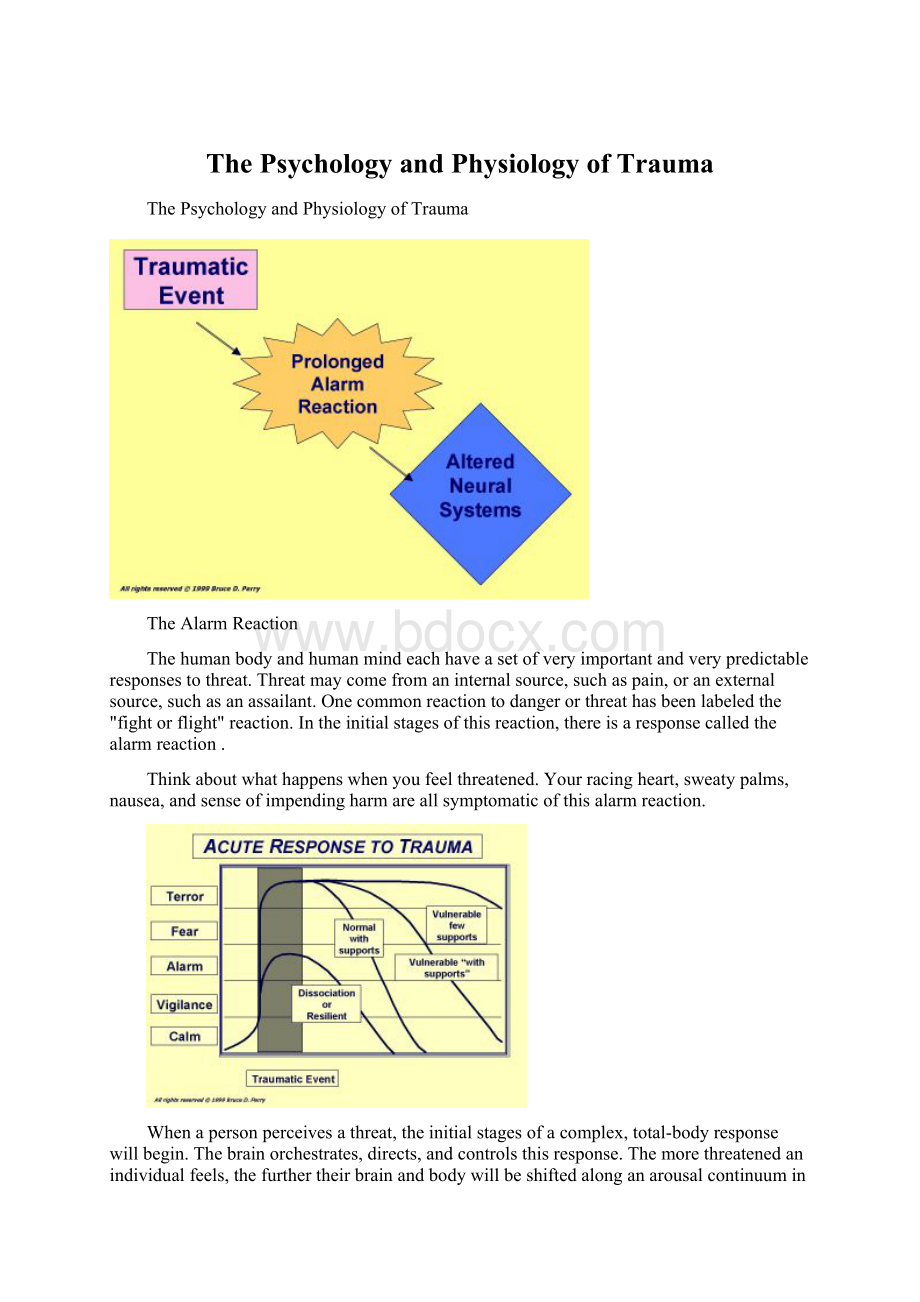The Psychology and Physiology of Trauma.docx
《The Psychology and Physiology of Trauma.docx》由会员分享,可在线阅读,更多相关《The Psychology and Physiology of Trauma.docx(10页珍藏版)》请在冰豆网上搜索。

ThePsychologyandPhysiologyofTrauma
ThePsychologyandPhysiologyofTrauma
TheAlarmReaction
Thehumanbodyandhumanmindeachhaveasetofveryimportantandverypredictableresponsestothreat.Threatmaycomefromaninternalsource,suchaspain,oranexternalsource,suchasanassailant.Onecommonreactiontodangerorthreathasbeenlabeledthe"fightorflight"reaction.Intheinitialstagesofthisreaction,thereisaresponsecalledthealarmreaction.
Thinkaboutwhathappenswhenyoufeelthreatened.Yourracingheart,sweatypalms,nausea,andsenseofimpendingharmareallsymptomaticofthisalarmreaction.
Whenapersonperceivesathreat,theinitialstagesofacomplex,total-bodyresponsewillbegin.Thebrainorchestrates,directs,andcontrolsthisresponse.Themorethreatenedanindividualfeels,thefurthertheirbrainandbodywillbeshiftedalonganarousalcontinuuminanattempttoensureappropriatementalandphysicalresponsestothechallengesofthethreat.Thecognitive(thinking),emotional,andbehavioralfunctioningoftheindividualwillallreflectthisshiftalongthearousalcontinuum.
Duringthetraumaticevent,allaspectsoftheindividual'sfunctioningchange,includingfeeling,thinking,andbehaving.Forinstance,someoneunderdirectassaultabandonsthoughtsofthefutureorabstractplansforsurvival.Atthatexactmoment,allofthevictim'sthinking,behaving,andfeelingisbeingdirectedbymoreprimitivepartsofthebrain.
Afrightenedchildinathreateningsituationdoesn'tfocusonthewordsbeingspokenoryelled;instead,heorsheisbusyattendingtothethreat-relatedsignalsintheirenvironment.Thefearfulchildwillkeyintononverbalsignsofcommunication,cuessuchaseyecontact,facialexpression,andbodyposture,orproximitytothethreat.
Theinternalstateofthechildalsoshiftswiththelevelofperceivedthreat.Withincreasedthreat,achildmovesalongthearousalcontinuumfromvigilancethroughtoterror.(Seetheabovegraphfordifferentpossibleresponsescenarios.)
TheArousalContinuum
Thearousalcontinuumischaracterizedbymanyphysiologicalchanges.Underthreat,sympatheticnervoussystemactivityincreasesinagradualfashion.Heartrate,bloodpressure,andrespirationarealteredduringthearousalresponse.Glucosestoredinmuscleisreleasedtopreparethelargeskeletalmusclesofyourarmsandlegsforeitherafightoraflight.
Thesechangesinthecentralnervoussystemcausehypervigilance;underthreat,thechildtunesoutallnon-criticalinformation.Theseactionspreparethechildtodobattlewithorrunawayfromthepotentialthreat.
Thistotalbodymobilization--thefight-or-flightresponse--hasbeenwellcharacterizedanddescribedingreatdetailforadults.Theseresponsesarehighlyadaptiveandinvolvemanycoordinatedandintegratedneurophysiologicalresponsesacrossmultiplebrainareas,includingthebrainstemnucleiresponsibleforautonomicnervoussystemregulation.
WhatDoesHyperarousalReallyMean?
Hyperarousalisamulti-dimensionalprocesscharacterizedbybothmentalandphysicalchanges.Theseincludeanincreaseintheactivityofthosepartsofthecentralandperipheralnervoussystemresponsiblefortheperceptionandprocessingofpotentiallythreateninginformation.Thisgradedresponsealsoinvolvesaction.
Duringthehyperarousalprocess,manyphysiologicalsystemsrequiredforsurvivalareactivated(e.g.,stressresponsehormonessuchascortisolandadrenaline).Themanyphysiologicalchangesduringhyperarousalwillinfluencethewayapersonthinks,feels,andacts.
Thefight-or-flightresponseisawell-characterizedreactiontodanger,aswe'vealreadydiscussed.Asecondcommonreactionpatterntothreatisdissociation.Dissociationisthementalmechanismbywhichonewithdrawsattentionfromtheoutsideworldandfocusesontheinnerworld.
Itisincreasinglyclearthatresponsestothreatcanvarytremendouslyfromindividualtoindividual.Thissecondmajoradaptationresponsetothreatinvolvesanentirelydifferentsetofphysiologicalandmentalchanges,yetdoesnotfallundertheheadingofeitherfightorflight.
Manycommonand"normal"mentalandemotionalstatessuchasanxiety,dissociation,orangerareexperiencedbymostofustosomedegree.Whenanyoneofthesebecomespervasiveandever-present,however,itbeginstointerferewiththerestofone'slife.Thiscanhappenwithdissociationandanxiety.Whenitdoeswecharacterizethisasadisorder.
Becauseoftheirsmallsizeandlimitedphysicalcapabilities,youngchildrendonotusuallyhavethefight-or-flightoptioninathreateningsituation.Whenfightingorphysicallyfleeingisnotpossible,thechildmayuseavoidantandpsychologicalfleeingmechanismsthatarecategorizedasdissociative.
Dissociationduetothreatand/ortraumamayinvolveadistortedsenseoftimeoradetachedfeelingthatyouareobservingsomethinghappentoyouasifitisunreal--thesensethatyoumaybewatchingamovieofyourlife.Inextremecases,childrenmaywithdrawintoanelaboratefantasyworldwheretheymayassumespecialpowersorstrengths.
Likethealarmresponse,this"defeat"ordissociativeresponseisgradedalongacontinuum.Theintensityofthedissociationvarieswiththeintensityanddurationofthetraumaticevent.(Rememberthatevenwhenwearenotthreatened,weusedissociativementalmechanisms,suchasdaydreaming,allofthetime.)Duringatraumaticevent,allchildrenandmostadultsusesomedegreeofdissociation.However,someindividualswilluse,orexperiencetraumathatinducesdissociationasaprimaryadaptiveresponse.
Formostchildrenandadultstheadaptiveresponsetoanacutetraumainvolvesamixtureofhyperarousalanddissociation.Duringtheactualtrauma,thechildfeelsthreatenedandthearousalsystemswillactivate.Withincreasedthreat,thechildmovesalongthearousalcontinuum.Atsomepointalongthiscontinuum,thedissociativeresponseisactivatedandahostofprotectivemental(decreasedperceptionofanxietyandpain)andphysiologicalresponses(decreasedheartrate)occur(seeFigure3-4below).
Thefollowingpointsareanoverviewofhumanresponsetothreatandtrauma.Don'tworryifyoudon'tgraspalltheconceptsatfirstreading.Wewillbediscussingtheseissuesingreaterdetailaswemovethroughourcourse.Considerthisapreviewofsorts.
∙Thebrainmediatesthreatwithasetofpredictableneurobiological,neuroendocrine,andneuropsychologicalresponses.
∙Theseresponsesmayincludedifferentsurvivalstrategies--rangingfromfightingorfleeingtogivinguporsurrendering.
∙Therearemultiplesetsofneurobiologicalandmentalresponsestostress.Thesevarywiththenature,intensity,andfrequencyoftheevent.Differentchildrenmayhaveuniqueandindividualizedsetsofresponsestothesametrauma.
∙Twoprimaryadaptiveresponsepatternsinthefaceofextremethreatarethehyperarousalcontinuum(defense--fightorflight)andthedissociationcontinuum(freezeandsurrenderresponse).Eachoftheseresponsesetsactivatesauniquecombinationofneuralsystems.
∙Theseresponsepatternsaresomewhatdifferentininfants,children,andadults--thoughtheysharemanysimilarities.Adultmalesaremorelikelytousehyperarousal(fightorflight)response,whileyoungchildrenaremorelikelytouseadissociativepattern(freezeandsurrender)response.
∙Ingeneral,thepredominantadaptivestyleofanindividualintheacutetraumaticsituationwilldeterminewhichpost-traumaticsymptomswilldevelop:
hyperarousalordissociative.
Exercise:
CatalogYourAlarmResponsePatterns
Thinkbacktothelasttimeyoufeltthreatenedinsomewayandyouralarmstatewasactivated.Perhapsyouwerewalkingdownadarkstreetonenightandheardfootstepsclosebehindyou.Perhapsyouwereattendingafootballgameoneafternoonwhensomebeer-swillingfansnexttoyoubeganafightwithafanoftheopposingteamseatedintherowbehindyou.
Picktwoorthreeeventsfromyourlifewhereyoufeltsomeelementofthreat.Foreach,maketwocolumns.Inthefirstcolumn,listtheemotionalandmentalchangesyouremember--forexample,asenseofunreality,intensefear,ortuningouttheworld.Intheother,listthephysicalsymptomssuchasracingheart,sweatypalms,orlight-headedness.Whatphysicalsymptomsdoyourecallemergingasyourbrainsentthesignaltoyourbodythatathreatwasnear?
Didyouwanttorun?
Didyoufeelanadrenalinsurgeinpreparationforpossibleself-defense?
Visualizeyourbodyandmakeamentallist,fromheadtotoe,ofeveryphysiologicalresponsetotheperceivedthreatthatoccurred.Thiscanillustratetwokeypoints:
1)youprobablyhadaslightlydifferentsetofadaptivechangesineacheventand2)themental(i.e.,psychological)andbody(i.e.,physiological)changesareinterrelated,interdependent,and,infact,componentsofthesameneurophysiologicalresponsetothreat.Itisnotusefuloraccuratetothinkof"psychological"vs."physical"responses.
ThePsychologyandPhysiologyofTrauma
Differentchildrenhavedifferentstylesofadaptationtothreat.Somechildrenuseaprimaryhyperarousalresponse,whileothersadaptaprimarydissociativeresponse.Mostchildren,however,adoptsomecombinationofthesetwoadaptivestyles.
Inthefearfulchild,adefiantstanceisoftenseen.Thisistypicallyinterpretedasawillfulandcontrollingchild.Ratherthanunderstandingthebehaviorasrelatedtofear,adultsoftenrespondtothe"oppositional"behaviorbybecomingangrierandevenmoredemanding.
Thechild,over-readingthenonverbalcuesofthefrust